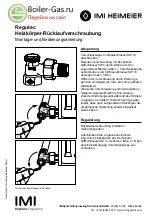
11
24/28/bi
24/28/bi
24/28/bi
24/28/bi
24/28/bi
live and neutral) to their corresponding terminals
on the terminal strip. Ensure that the EARTH wire
is left slightly longer that the others, this will pre-
vent strain on the Earth wire should the cable
become taut.
Do not remove the link Do not remove the link
wire (between terminals 1 & 3) unless additional
external controls are to be fitted (see section 8).
Re-fit the electrical connection cover. The secur-
ing screw on the cable anchorage must be tight-
ened before the connection cover is replaced.
Fig. 10A
Fig. 10B
4.9.1
INTERNAL ACCESS (fig. 10A)
To gain internal access to the appliance, it’s nec-
essary to remove the appliance casing (Rain only)
and the control panel securing screw (see fig. 10A).
Locate and remove the 2-screws (A) that secure
the appliance casing (Rain only) and gently ease
and lift away the casing from the appliance.
Locate and remove the control panel securing
screw (see fig. 10B) and push down on clip ‘C’ to
release the control panel.
SECTION 5 COMMISSIONING
5.1
GAS SUPPLY INSTALLATION
Inspect the entire installation including the gas
meter, test for soundness and purge. Refer to I.S.
813 for specific instruction.
5.2
THE HEATING SYSTEM
The appliance contains components that may
become damaged or rendered inoperable by oils
and/or debris that are residual from the installa-
tion of the system, consequently it is essential
that the system be flushed in accordance with the
following instructions.
5.3
INITIAL FILLING OF THE SYSTEM
Ensure both flow and return service valves are
open, remove appliance casing as described in
4.8.3, identify the automatic air release valve and
loosen the dust cap by turning the cap anti-
clockwise one full turn. IMPORTANT, THERE
ARE NO MANUAL AIR RELEASE VALVES LO-
CATED ON THE APPLIANCE. Ensure all manual
air release valves located on the heating system
are closed. Using the method of filling as de-
scribed in fig. 5, slowly proceed to fill the system.
As water enters the system the pressure gauge
will begin to rise. Once the gauge has reached 1
BAR close the filling valve and begin venting all
manual air release valves, starting at the lowest
first. It may be necessary to go back and top-up
the pressure until the entire system has been
filled. Inspect the system for water soundness,
rectifying any leaks.
5.4
INITIAL FLUSHING
The whole of the heating system must be flushed
as detailed in 5.8. Open all radiator or heating
valves and the appliance flow & return service
valves. Drain the boiler and system from the
lowest points. Open the drain valve full bore to
remove any installation debris from the boiler
prior to lighting. Refill the boiler and heating
system as described in 5.3.
5.5
PRE-OPERATION CHECKS
Before attempting the initial lighting of the appli-
ance, the following checks must be carried out:
●
ensure all gas service valves from the meter to
the appliance are open and the supply pipe has
been properly purged
●
ensure the proper electrical checks have been
carried out, (see 7.7) particularly continuity,
polarity, and resistance to earth
●
ensure the 3 AMP fuse - supplied with the
appliance - has been fitted
●
ensure the system has been filled, vented and
the pressure set to 1 BAR
●
ensure the flue system has been fitted properly
and in accordance with the instructions
●
ensure all appliance service valves are open.
5.6
INITIAL LIGHTING
Ensure the electrical supply to the appliance is
switched on. Switch the time clock or program-
mer (if fitted) to an ‘on’ position and ensure all
external controls are also calling for heat. Turn
the mode selector knob to the ‘on’ position (fig. 1).
The appliance will now go through an ignition
sequence as described in 1.2. Should the appli-
ance fail to ignite, refer to 5.5 and/or section 7
(fault-finding).
5.7
CHECKING THE BURNER PRESSURE
Although the burner pressure is factory set, it is
necessary to check it during commissioning
.














































